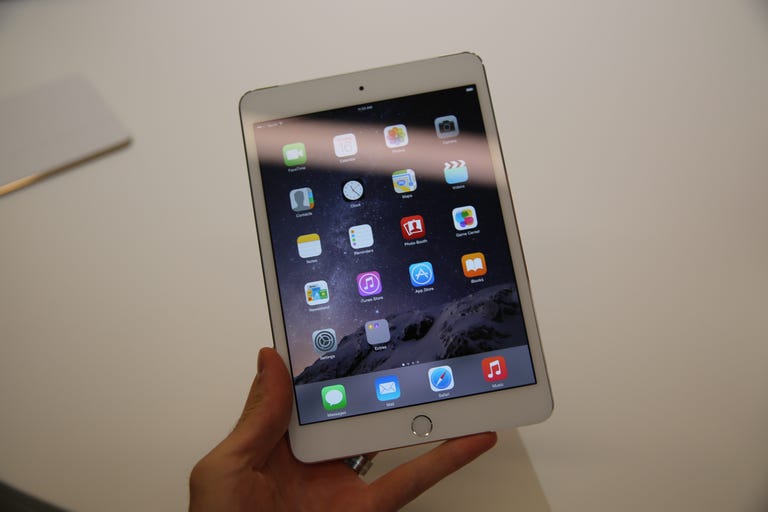 Why You Can Trust CNET
Why You Can Trust CNET Apple iPad Mini 3 review: A great tablet, but no longer the best deal
2014's iPad Mini 3 is little changed, getting just Touch ID and a new color compared to the previous year. Can it still compete in the fiercely competitive mid-sized tablet market?
Review update: Summer 2015
At its Worldwide Developers Conference in June 2015, Apple introduced the next edition of its mobile operating system, iOS 9 , which heralds some important changes to come for the iPad portfolio. Significantly, iOS 9 will bring to the iPad Air 2 split-screen multitasking, allowing users to view two apps on the same screen (other existing iPad models will not support this feature).
The Good
The Bad
The Bottom Line
The Air 2, original Air, Mini 2 and Mini 3 will support the operating system's new picture-in-picture functionality. And yes, these are features that have been around for quite a while on competitors' tablets such as the Samsung Galaxy line and Microsoft's Surface .
Apple also announced that iOS 9 will support using a portion of the screen as a digital trackpad, which would ostensibly make it easier to edit and move items around on the iPad. (Note that some have predicted that ForceTouch, introduced on the latest Apple laptops, could also show up on the next iPad.)
For now, iOS 9 is available only to developers; the company will open the beta version to the public in July in advance of a general release later this fall. In the meantime, you can read more about how iOS 9 could transform the future of the iPad.
Meanwhile, anyone considering buying an iPad Mini 3 (or any other iPad models) should note that Apple will almost certainly initiate some combination of an iPad line update and a price drop on earlier models in October 2015. Whether that update includes an iPad Air 3, iPad Mini 4 and/or a rumored big-screen iPad Pro remains to be seen.
Editors' note:This review has been updated from the version that was originally published on October 21, 2014.
The iPad Mini 3
The iPad Mini 3 has the same 7.9-inch, 2,048x1,536-pixel display that made 2013's iPad Mini 2 such a huge upgrade over its lower-res predecessor. The display still looks great at all angles, with plenty of contrast, great color reproduction and all the IPS goodness you've come to expect.
It's powered by the same A7 processor as the Mini 2, running at 1.27GHz and paired with 1GB of RAM. That gives this slate plenty of performance for most situations; indeed, matching the original iPad Air for the most part. But, as the new iPad Air 2 gets bumped to a 1.94GHz A8X chip and steps up to 2GB of RAM, it's hard to not look on somewhat enviously.
Still, the Mini 3 is a competent performer. We spun up all of our favorite games, and everything is perfectly playable. Nothing skipped a beat or missed a frame. So it goes for Web surfing. Safari loads pages quickly and offers a perfectly responsive touch experience. Plus, the 473ms SunSpider score is nothing to sneeze at -- though that does make it about a third slower than the Air 2. That noted, it remains to be seen how well the Mini 3 will handle the upcoming iOS 9 update.
It's all housed in the same chassis as the Mini 2, with the rounded edges and other styling cues seen on the iPhone 6. While it still looks fresh, the Mini 2 measures 7.5mm thick -- making it look a bit portly next to the 6.1mm iPad Air 2. The Mini 3's battery life doesn't disappoint and is still rated for the same 10 hours as the previous model. In our testing, we easily managed a full day of serious use. Cameras, too, remain the same: 1.2 megapixel in the front, 5 megapixel in the rear.
The significant upgrade from Mini 2 to Mini 3 is the addition of Touch ID. Yes, you can finally unlock your iPad Mini just by touching the Home button. This also opens the door to iTunes authorizations without typing in your password.
Apple Pay has made its way onto the iPad Mini 3, but without NFC for tap-to-pay. Instead, the iPad stores credit card information centrally and allows apps that choose to fold in Apple Pay to use it to make one-touch payments. The whole set-up process is effortless and works quickly, and Apple Pay continues to gain traction and retail partners.
Another feature worth mentioning is Apple's SIM for the cellular model, which enables activation on any (approved) carrier you like. Beyond that, the only other tweak over the previous model is the choice of a golden exterior in addition to silver or space gray. And...that's it. Everything else is the same.
Is it worth the premium for Touch ID? If you need the extra storage, then you don't have much choice. Or, perhaps if you're really craving that gold color, and if so, we certainly won't judge. Otherwise, it's a bit of a tough sell.
The iPad Mini 3 is a great tablet. It's the perfect size for those who want something a little more mobile than the Air, and its mixture of performance, battery life and aesthetics still place it among the best small tablets on the market. For these reasons, it remains among our favorite mini tablets. That noted, the very similar and still-available Mini 2 is even less expensive, making it the better bargain.


